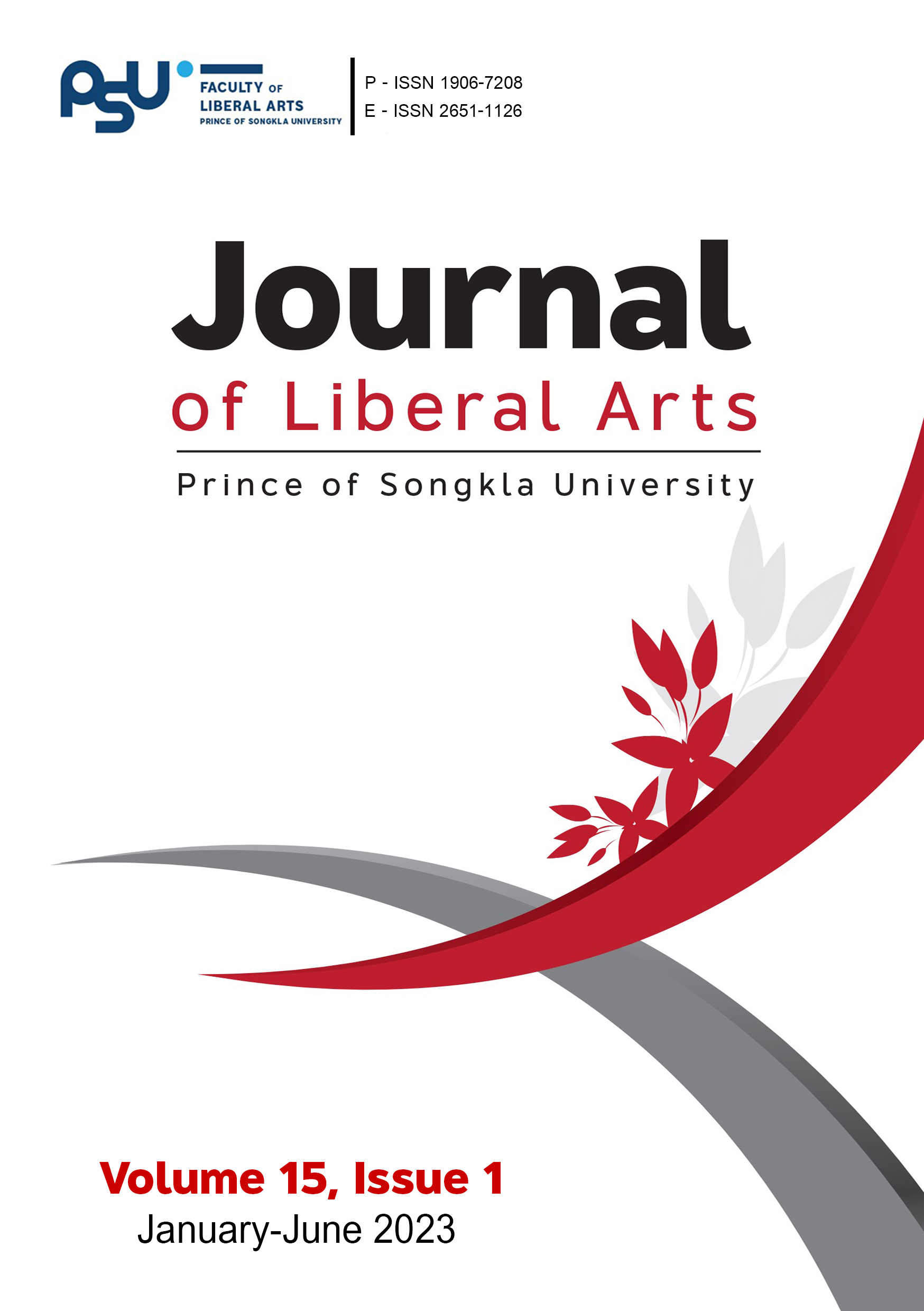The Role of Future Self-Guides in Motivated Language Learning Behaviors: The Case of English and Chinese Language Learners in Thailand
DOI:
https://doi.org/10.14456/jlapsu.2023.1Keywords:
The 2x2 model of future self-guides, motivated language learning behaviors, English and Chinese, Thai university studentsAbstract
Based on the 2x2 model of future self-guides, a revision of future self-guides which is used to explain students’ motivated behaviors in language learning, this mixed-method study investigated: (1) the extent to which students’ motivations to learn English and Chinese are regulated by each component of future self-guides; (2) the relationship between future self-guides and motivated language learning behaviors; and (3) students’ perceived motivation in learning English and Chinese. Motivational questionnaires were distributed to 136 Thai university students (64 English majors and 72 Chinese majors), and follow-up semi-structured interviews were conducted with 15 English majors and 15 Chinese majors. The results showed that the students’ motivations to learn English and Chinese were highly regulated by future self-guides. It was also found that Ideal L2 Self from own standpoint was the component that was most highly correlated with motivated language learning behaviors for both English and Chinese majors, followed by Ideal L2 Self from other standpoint, and Ought-to L2 Self from own standpoint respectively. Ought-to L2 Self from other standpoint showed the weakest correlation to motivated language learning behaviors. The interview data indicated that the instrumental values of the target languages, significant others’ expectations, and perceived self-obligations were perceived as contributing factors to their motivation to learn both languages. This paper offers pedagogical implications as well as recommendations for further research.
References
Al-Hoorie, A. (2018). The L2 motivational self system: A meta-analysis. Studies in Second Language Learning and Teaching, 8, 721–754.
Baker, W., & Jarunthawatchai, W. (2017). English language policy in Thailand. European Journal of Language Policy, 9(1), 27-44.
Blair, R., & Azaz, M. (2019). Self-guide distinctions and episodic memory in L2 motivation: The case of Arabic in the United States. System, 81, 192-205.
Boo, Z., Dörnyei, Z., & Ryan, S. (2015). L2 motivation research 2005–2014: Understanding a publication surge and a changing landscape. System, 55, 145-157.
By, H., & Laohawiriyanon, C. (2019). The L2 motivational self-system of low and high achievers in a Cambodian context. Journal of Language Teaching and Learning in Thailand, 57, 67-100.
Csizér, K., & Lukács, G. (2010). The comparative analysis of motivation, attitudes and selves: The case of English and German in Hungary. System, 38, 1-13.
Csizér, K., & Kormos, J. (2009). Learning experiences, selves and motivated learning behaviour: A comparative analysis of structural models for Hungarian secondary and university learners of English. In Z. Dörnyei & E. Ushioda (Eds.), Motivation, language identity and the L2 self (pp. 98–119). Multilingual Matters.
Dörnyei, Z. (2005). The psychology of the language learner: Individual differences in second language acquisition. Lawrence Erlbaum.
Dörnyei, Z. (2009). The L2 motivational self system. In Z. Dörnyei & E. Ushioda (Eds.), Motivation, language identity and the L2 self (pp. 9-42). Multilingual Matters.
Dörnyei, Z., & Chan, L. (2013). Motivation and vision: An analysis of future L2 self images, sensory styles and imagery capacity across two target languages. Language Learning, 63, 437-462.
Dörnyei, Z., & Ryan, S. (2015). The psychology of the language learner revisited. Routledge.
Dörnyei, Z., & Ushioda, E. (2011). Teaching and researching motivation (2nd ed.). Pearson Education.
Feng, L., & Papi, M. (2020). Persistence in language learning: The role of grit and future self-guides. Learning and Individual Differences, 81, 1-10.
Higgins, E. T. (1987). Self-discrepancy: A theory relating self and affect. Psychological Review, 94, 319–340.
Huang, H. T., Hsu, C. C., & Chen, S. W. (2015). Identification with social role obligations, possible selves and L2 motivation in foreign language learning. System, 51, 28-38.
Lamb, M. (2012). A self-system perspective on young adolescents’ motivation to learn English in urban and rural settings. Language Learning, 62, 997–1023.
Markus, H., & Nurius, P. (1986). Possible selves. American Psychologist, 41, 954–969.
Papi, M., Bondarenko, A., Mansouri, S., Feng, L., & Jiang, C. (2018). Rethinking L2 motivation: The 2 × 2 model of self-guides. Studies in Second Language Acquisition, 40, 1–25.
Papi, M., & Teimouri, Y. (2012). Dynamics of selves and motivation: A cross-sectional study in the EFL context of Iran. International Journal of Applied Linguistics, 22, 287–309.
Siridetkoon, P. (2015). Motivation, anxiety and international posture of multiple language learners in Thailand [Unpublished doctoral dissertation]. University of London.
Teimouri, Y. (2017). L2 selves, emotions and motivated behaviors. Studies in Second Language Acquisition, 39, 681–709.
Tungkeunkunt, K. (2016). Culture and commerce: China’s soft power in Thailand. International Journal of China Studies, 7(2), 115-173.
Ushioda, E. (2017). The impact of Global English on motivation to learn other languages: Toward an ideal multilingual self. The Modern Language Journal, 101(3), 469-482.
Ushioda, E., & Dörnyei, Z. (2017). Beyond Global English: Motivation to learn languages in a multicultural world: Introduction to the special issue. The Modern Language Journal, 101(3), 451-454.
You, C. J., & Dörnyei, Z. (2014). Language learning motivation in China: Results of a large-scale stratified survey. Applied Linguistics, 37, 495–519.
Downloads
Published
How to Cite
Issue
Section
License
Copyright (c) 2023 Xiaopeng Zhang, Asst.Prof.Dr. Chonlada Laohawiriyanon

This work is licensed under a Creative Commons Attribution-NonCommercial-NoDerivatives 4.0 International License.
The authors retain the copyright to their article but the Journal of Liberal Arts, Prince of Songkla University reserves the exclusive rights to first publication.






